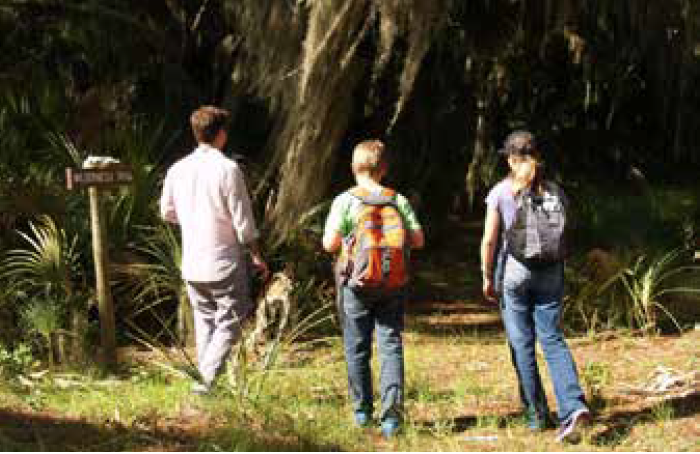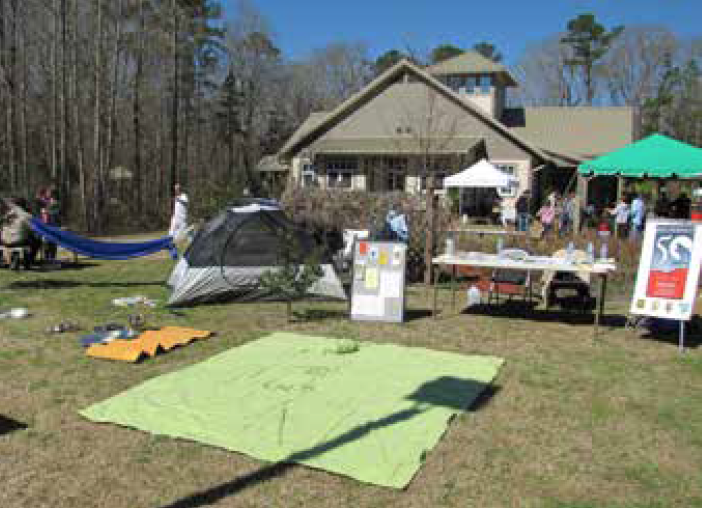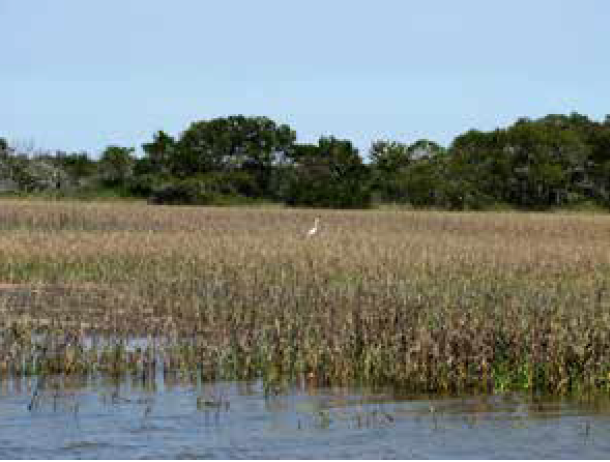Education & Communication
August 2015 | Volume 21, Number 2
BY JOHN PEDEN, MADALYN RUSSELL, and MONICA HARRIS
At the 2014 National Wilderness Conference in Albuquerque, New Mexico, a clear theme inherent in many of the keynote addresses and concurrent sessions was the need for more wilderness education. Former U.S. president Jimmy Carter, U.S. Department of the Interior secretary Sally Jewell, and New Mexico senator Martin Heinrich, among others, emphasized the need to connect young people to wilderness and educate diverse audiences about the benefits of an enduring and expanded system of federally protected wilderness. This is particularly important in an age where youth are spending less time involved in nature-based outdoor activities (Larson, Green, and Cordell 2011; Louv 2008). This article reports on a service-learning partnership between the Savannah Coastal Refuges Complex and a public university in the southeastern United States. We discuss the advantages of service-learning as a means of promoting wilderness education from the perspectives of the managing agency and students who participated in the project. We also offer recommendations and resources for establishing similar partnerships in other areas of the United States.
Wilderness Education
Wilderness education encompasses a broad array of approaches for connecting people with wilderness, promoting awareness of wilderness benefits, developing understanding of wilderness legislation, and encouraging sound stewardship of wilderness resources. It occurs in both educational and recreational settings, and involves stakeholders within government agencies, as well as those external to such organizations. Examples include the Wilderness Management Distance Education Program at The University of Montana (www.wmdep.wilderness.net), the Wilderness Stewardship Certificate Program offered by the Eppley Institute for Parks and Public Lands (www. eppley.org), the field courses, e-courses, and webinars available through the Arthur Carhart National Wilderness Training Center (www.carhart.wilderness.net), and educational and interpretive programs offered by agencies that manage wilderness. Although the goals of these programs vary based on intended audiences, management objectives, and other factors, they share the common purpose of improving communication and decision making as it pertains to the preservation of wilderness character.
Most wilderness education that takes place in the United States is targeted at agency personnel with the intention of improving internal communication and decision making. Although a clear need exists to educate the public about the importance of wilderness, such programs appear to be relatively rare. This is due in part to a lack of resources and competition with other management priorities. For example, personnel with the U.S. Fish and Wildlife Service recognize the importance of preserving wilderness character and promoting stewardship of wilderness resources. Wilderness education is considered to be a valuable management tool, but staff members rarely have the time to design and implement programs that educate the public about local wilderness resources. As a result, most wilderness education efforts are dependent on nonpersonal interpretive approaches (e.g., brochures, kiosks, websites), which have been shown to be less effective than interpretive talks, guided tours, educational programming, and other personal approaches (Manning 2003). In today’s fiscal environment, agency personnel are often required to seek creative solutions when offering wilderness education programs to the public.
Service-Learning
Service-learning is a form of experiential education that requires students to conduct meaningful volunteer work that enhances learning outcomes in academic courses. Effective service-learning requires a clear link between academic course objectives and the needs of the partner organization. Additionally, it should involve structured reflection designed to promote understanding of course content, broader knowledge of the discipline, and a sense of civic responsibility (Bringle and Hatcher 1996). Service-learning has been shown to influence higher order thinking, cultural awareness, personal and interpersonal development, academic motivation, self-efficacy, and civic engagement (Warren 2012).
Service-learning has been used as a pedagogical strategy in a wide range of fields, including nursing, child development, physical education, and teacher education (Whitley and Walsh 2014). Despite its seeming applicability in natural resource management, Newman, Bruyere, and Beh (2007) note that service-learning remains underutilized and understudied. They emphasize that students in such fields value experiential learning and are attracted to their respective majors, at least in part, by the desire to work outside in a hands-on environment. Service-learning has considerable potential as a means of providing wilderness education – one that benefits students, wilderness managers, community members, and academic institutions alike. It is a way for students to learn about the value of wilderness, while strengthening their interpretive skills and educating others about the importance of local wilderness resources. It also allows understaffed and underfunded agencies to ensure that the important story of wilder-ness is communicated to the public.
Natural Resources Discovery Day
In March 2014, Georgia Southern University students in an environmental education and interpretation course planned and delivered formal and informal interpretive talks on the Wilderness Act of 1964 and Leave No Trace principles for Natural Resources Discovery Day, a community event hosted by the Savannah Coastal Refuges Complex of the U.S. Fish and Wildlife Service. Spanning more than 100 miles (161 km) of coastline in South Carolina and Georgia, the complex includes seven national wildlife refuges and two federally protected wilderness areas – Blackbeard Island Wilderness (3,000 acres/1,214 ha) and Wolf Island Wilderness (5,126 acres/2074 ha).
The purpose of Natural Resources Discovery Day is to increase public awareness of the Coastal Refuges Complex and the mission of the U.S. Fish and Wildlife Service. First held in 2011, this full day event has expanded to include a broad array of partner organizations that conduct interpretive talks, educational programs, and recreational activities at the Refuge Visitor Center. Georgia Southern’s involvement originated when the visitor services manager contacted the course instructor about opportunities for collaboration. Wilderness was selected as the topic because of an identifiable need for wilderness education within the region.
One of the objectives of the interpretation course was that all students would plan and deliver an interpretive talk. Students were invited to participate in Natural Resources Discovery Day and had the option to conduct their talk during the event. They were told that the general topic would be wilderness, and that they would be responsible for working with the visitor services manager and the course instructor to refine their ideas. A total of six students, working in teams of two, developed formal interpretive talks that explained the Wilderness Act of 1964, its relevance throughout the last 50 years, the benefits of local wilderness areas, and the importance of wilderness stewardship. They also conducted Leave No Trace (LNT) demonstrations and informal interpretive talks that focused on the importance of minimizing depreciative behavior in local wilderness areas.
The development and delivery of personal interpretive programs was covered in class during the weeks preceding the event. Students were responsible for creating outlines that included purpose statements, objectives, and themes. They discussed delivery methods, time limitations, and how they would incorporate the interpretive principles covered in class. The outlines were reviewed by the visitor services manager and the course instructor prior to the event, feedback was incorporated, and the students rehearsed in advance.
Student Perspectives
Successful service-learning experiences result in application of course material, perspective transformation, a developed sense of citizenship, and personal and interpersonal development (Eyler and Giles, as cited in Warren 2012). Structured reflection on student involvement in Natural Resources Discovery Day was conducted through written responses to a series of open-ended questions that focused on the objectives of the project. Analysis of these responses revealed three primary themes: improved understanding of interpretive principles, increased awareness and understanding of wilderness, and personal and professional development.
Improved Understanding of Interpretive Principles
Effective wilderness education requires an understanding of wilderness legislation, the benefits of wilderness, and threats to existing wilderness resources. However, it is equally important that this information is communicated in a relatable manner that sparks interest and retention among diverse audiences. Students learned about Tilden’s Six Principles of Interpretation (Tilden 2008) and applied what they learned to effectively communicate with their audience. One student stated: “The project allowed for even further and more technical use of the interpretive strategies discussed in class.” Students relied on all six of the principles during their experience at Natural Resources Discovery Day, with the first (information must be presented in a manner that is relevant to the audience), third (interpretation is an art), and sixth (interpretation should be developmentally appropriate) proving to be particularly important: “This project really helped me appreciate the importance of knowing information thoroughly and understanding its significance to the audience.” The students also acknowledged the importance of creativity when choosing interpretive strategies: “In order to be an effective wilderness educator, seeing the interpretive talk as a form of art, rather than simply an educational seminar is key.” The importance of developmentally appropriate messaging was illustrated by a student who stated: “Sharing the presentation with such a wide variety of participants required the talk to be tailored to specific ages, interests, and education levels.” Finally, students emphasized that working outside of the typical classroom setting was beneficial to their understanding of interpretation: “We need this type of experience to truly understand and implement interpretive strategies in our current coursework and future careers.”
Increased Awareness and Understanding of Wilderness
The heart of service-learning resides in meaningful volunteer work that ultimately results in enhanced educational outcomes. Natural Resources Discovery Day provided students with the opportunity to interpret one of the most significant pieces of environmental legislation in history (Dawson and Hendee 2008). Doing so not only broadened the audience’s understanding of wilderness but also enhanced students’ knowledge and instilled a personal desire to develop the next generation of wilderness stewards. Prior to participation in the project, students had a basic understanding of the Wilderness Act and how it has changed the way land is valued and managed. The preparation that went into the project led to increased knowledge of wilderness legislation and the management actions taken to protect these unique natural areas:
“The project provided valuable insight regarding ways that wilderness areas are protected and managed.” Students also developed greater appreciation for the benefits of wilderness: “Participating in this project taught me a lot about wilderness and what makes it so special.” Although the students did not visit Blackbeard Island and Wolf Island Wilderness Areas, simply observing the environmental integrity of the complex exemplified the definition of wilderness and benefits of the act: “Seeing the natural beauty of the refuge allowed our talks to come to life, and my appreciation for the refuge grew.” Transformed perspectives on the importance of wilderness ultimately led to an enhanced sense of civic engagement: “We made a difference in the way the public saw and understood wilderness areas, which is truly the point of my education.”
Personal and Professional Development
Applying educational and interpretive skills at the Savannah Coastal Refuges Complex provided students with critical field experience necessary to succeed in their careers. Students were able to practice their skills and experience firsthand how federal agencies provide special events for the public: “Seeing Monica at work, leading groups of all ages at Savannah National Wildlife Refuge gave me an idea of what my career could potentially entail.” Students were also inspired to gain additional knowledge about wilderness and more experience as educators. One student noted the motivation instilled by the opportunity to apply concepts learned in class: “This was not just for a grade. I was there to test myself, evaluate my performance, and convey a message to help shape values.” Another student explained how the experience transformed her perspectives on the importance of wilderness education: “Today’s upcoming generation is so buried beneath progress and technology. Participants at this event gave me a new appreciation for today’s youth and a sense of optimism about the future of wilderness.” Students in general were inspired to promote wilderness education within their communities and felt that events such as Natural Resources Discovery Day are necessary to spread awareness about wilderness and other unique ecosystems that the public often overlooks.
Conclusions and Recommendations
Natural Resources Discovery Day led to the application of course material, perspective transformation, a developed sense of citizenship, and personal and interpersonal development, all of which are critical indicators of successful service-learning (Eyler and Giles, as cited in Warren 2012). The project also proved beneficial to the Savannah Coastal Refuges Complex. One refuge employee stated: “Many people don’t realize that refuges often have designated wilderness areas within their boundaries. They tend to think of wilderness as any remote place without development, and don’t realize that designating a wilderness area requires congressional action.” The students’ work also assisted the FWS in communicating rules and regulations designed to protect wilderness and promote quality visitor experiences: “Be it within a national wildlife refuge or other public lands, there are regulations and ethics specific to wilderness that the public needs to be aware of prior to visiting. These regulations are above and beyond those that apply to the refuge itself, and prior awareness can help ensure that visitors have a safe and enjoyable experience.”
Reviewing successes and areas for improvement reinforces the benefits of service-learning while strengthening the value of the experience. Consultation between students, the FWS, and the instructor-led to several recommendations for those interested in using service-learning projects to promote wilderness education.
A common constraint identified by students was the variety of age groups within the audience. This led to different understandings of the term wilderness and challenged students to present information in a relatable manner. Wilderness educators should employ best practices in interpretation to create awareness and instill values that promote behavioral change and a sense of stewardship. For example, developmentally appropriate interpretation practices can be used to engage younger audiences by comparing the benefits of a backyard wilderness to those of a federally protected wilderness area.
Second, Leave No Trace principles should be incorporated into wilderness education programming to demonstrate the impacts that out-door recreation has on other visitors and the environment (Marion 2014). Many of the audience members were unfamiliar with LNT principles and did not understand the importance of using these practices to protect wilderness character. This connection could have been strengthened by having the students identify a common purpose and interpretive objectives across teams. Instead, each team planned separately with individualized goals and objectives. In order for the audience to under-stand the connection between LNT principles and the preservation of wilderness character, talks should incorporate complementary ideas and outcomes.
Effective interpretation allows the audience to form emotional connections with natural and cultural resources (Bacher et al. 2007). This is more likely to occur when wilderness educators have forged those connections themselves. A third recommendation is to provide opportunities for students to visit the areas they will be interpreting in advance. This was particularly challenging with Natural Resources Discovery Day because the two federally designated wilderness areas within the Savannah Coastal Refuges Complex are located offshore, and are only accessible by boat. However, visiting these areas in advance would have allowed the students to share their own firsthand perspectives on the experiential, scientific, spiritual/symbolic, and economic benefits inherent in these unique areas.
Finally, it is important to plan for continuity. Although service-learning projects do not have to be repeated to be effective, a primary rationale for wilderness education partnerships is to provide federal agencies with a reliable and effective means of delivering programs to the public.
A lasting partnership makes this possible, and also helps justify the considerable time and effort required to successfully plan and implement service-learning projects. Agency representatives and their university counterparts should discuss the long-term goals of the partnership, along with plans for implementation. The project described in this article will continue to be incorporated into a spring course, and additional opportunities to utilize service learning as a means of promoting wilderness education are currently being explored. The ultimate goal is to provide a beneficial service to public land managers, promote awareness of local wilderness resources, and develop the next generation of wilderness stewards.
VIEW MORE CONTENT FROM THIS ISSUE
JOHN PEDEN is an associate professor at Georgia Southern University where he seeks to inspire the next generation of wilderness stewards; email: jpeden@ georgiasouthern.edu.
MADALYN RUSSELL is an undergraduate student at Georgia Southern University with a passion for connecting people with the natural world; email: madyr@ comcast.net.
MONICA HARRIS is the visitor services manager for the Savannah Coastal Refuges Complex. She is a nature-lover, Girl Scout leader, and environmental educator; email: monica_harris@fws.gov.
References
Bacher, K., A. Balthrus, B. Barrie, K. Bliss, D. Cardea, L. Chandler, D. Dahlen, J. Friesen, R. Kohen, and B. Lacome. 2007. Foundations of Interpretation Curriculum Content Narrative. USDI National Park Service. Retrieved from www.nps.gov/idp/interp/101/FoundationsCurriculum.pdf.
Bringle, S. R., and J. A. Hatcher. 1996. Implementing service-learning in higher education. Journal of Higher Education 67(2): 221–239.
Dawson, C. P., and J. C. Hendee. 2008. Wilderness Management: Stewardship and Protection of Resources and Values, 4th ed. Golden, CO: Fulcrum Publishing.
Larson, L. R., G. T. Green, and K. H. Cordell. 2011. Children’s time outdoors: Results and implications of the national kids survey. Journal of Park and Recreation Administration 29(2): 1–20.
Louv, R. 2008. Last Child in the Woods: Saving Our Children from Nature Deficit Disorder, 2nd ed. Chapel Hill, NC: Algonquin Books.
Manning, R. E. 2003. Emerging principles for using information/education in wilderness management. International Journal of Wilderness 9(1): 23–27.
Marion, J. L. 2014. Leave No Trace in the Outdoors. Mechanicsburg, PA: Stackpole Books.
Newman, P., B. L. Bruyere, and A. Beh. 2007. Service-learning and natural resource leadership. Journal of Experiential Education 30(1): 54–69.
Tilden, F. 2008. Interpreting Our Heritage, 4th ed. Chapel Hill: University of North Carolina Press.
Warren, J. L. 2012. Does service-learning increase student learning? A meta-analysis. Michigan Journal of Community Service Learning 56–61.
Whitley, M. A., and D. S. Walsh. 2014. A framework for the design and implementation of service-learning courses. Journal of Physical Education, Recreation & Dance 85(4): 34–39.





